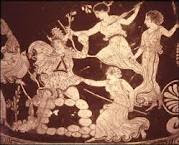I admire the folks who are out in the public squares protesting the ever greater inequality of wealth in this country; the ever greater power of the corporation in writing laws to enrich themselves; the ever lesser power of the people over the political process and over the means of production. I am following the Occupy movement closely and I hold out hope that this will transform over time into a lasting political movement.
However, I am too old and have too many place-based responsibilities to be out there myself. If I were bedding my old bones down on the concrete in Westlake center (ha!), who would be feeding the pigs, milking goats, preserving the harvest? Who would be controlling the means of production at MY house?
In other words, people, there is more than one way to protest. Civil disobedience is awesome and irreplaceable as a means of focusing attention. But the quiet protest of refusing to give your dollars to Monsanto, Cargill, Bayer, Halliburton, GE, and Texaco (among many others) by instead growing your own food, saving your own seed, producing your own electricity, brewing your own biodiesel, and sewing your own clothes is perhaps even more effective.
I'm not trying to say we do all of those things - far from it. But we do many of them. And I am learning how to do more of them. Even if we never reach the point of producing all our own energy, or growing all our own food, having the knowledge base in the community, keeping the traditional wisdom alive is so important. I am quantifiably less dependent on those corporations because I can meet a healthy percentage of my own needs. I have given them a heck of lot less of my money than most Americans (and spent less overall), because I have developed some skills to replace their services.
I may not be out there, visible, but I am a protester nonetheless. And I am as subversive as hell.
Aimee's recommended ways to be subversive in modern America:
1) Maximize your food independence. For some of us, that means growing a lot of food or raising animals. For others, it means learning how to cook from scratch. If you are buying raw materials from your local farmers at the farmer's market, you maximize support of your individual neighbors and minimize your support of the giant agribusiness companies. You also save money and eat better.
2) Buy secondhand. Everything you possibly can. In this way you avoid encouraging the extraction of raw materials and extend the useful life of products. The embedded energy cost in, say, a new car or a new set of dining room furniture - even a new winter coat! - can be stretched over a greater time period and made to serve a greater number of people. For me, buying secondhand clothing is an ethical decision to avoid supporting the sweatshop industry. A subclause to this recommendation is: repair things that can be repaired. Get your fridge fixed a few times before you get a new one. Learn to mend clothes. When was the last time you saw a kid wearing jeans with knee-patches on them, unless they were sold that way to begin with? Take good care of your car. Do all the scheduled maintenance. Learn to do it yourself! Or ask your neighbor.
3) Maximize your energy independence. There are so many ways to do this - we brew biodiesel for our cars. But you might do it with solar panels or windmills, depending on where you live. Or do it by not owning a car and biking instead. Or by living in a smaller house and super-insulating. The sky's the limit.
4) Know your neighbors. Make friends. Develop mutually beneficial networks. Support each other. Lend your tools. Pool your resources. Why should every small-farming family along the same stretch of road own its own haying equipment, for example? That's absurd. Or its own tractor, even? Why shouldn't three or four families get together to buy one tractor instead of four? Does every household really need a chainsaw? No, not if you are on good terms with Bob down the way. And not if you are willing to lend his wife your sewing machine.
5) Most important of all: take charge of your education! Be informed! Get your information from diverse sources. Use your brain. Teach your kids. Go to museums and libraries while they still exist! Buy books (secondhand, of course!). Do not default on your obligation to educate your children, or yourself. It's too important. You can't leave it to the public school system alone. Talk about important issues with your spouse, your neighbor, your kids, your in-laws, your city councilman, your state senator!
6) For the love of God, VOTE!














